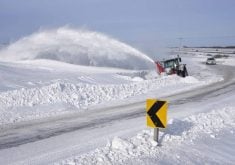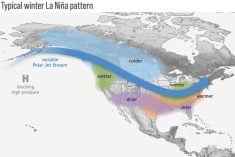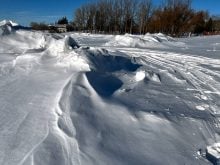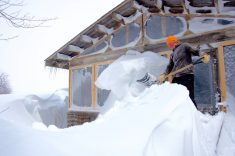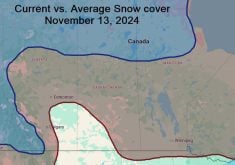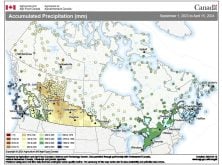The number of recent weather questions has dropped to nothing. Maybe we have answered all the weather questions! Whenever this happens and nothing major has occurred weather-wise in our neck of the woods, I like to look back at some of my weather articles from the last 19 years.
That’s right, by the end of December it will be 19 years of writing weekly weather articles. Amazing how time flies. An article from about six years ago was about snowfall probabilities, so let’s take another look at this topic.
The concept for that article arose when I came across one of my university courses on water systems. It was about stream flows and how to calculate the probability of 25, 50 and 100-year floods. Once I learned how to do that, I began thinking about snowstorms and about how often we might expect big storms.
Read Also

October rain recharges Manitoba soils
Daniel Bezte looks back on October weather on the Prairies and looks ahead to see whether there’s any consensus for this winter’s weather.
I went through all the data for Winnipeg, a nice central region, and applied the same probability techniques I learned for stream flooding to winter snowfall events, since the statistical theory is sound for both things. Let’s dig into the numbers.
When we look at snowfall data, there are different periods in which you can measure snowfall or precipitation. The most common method is to measure the amount of snow that falls in one day, from midnight to midnight. This is easy enough, since this is the way precipitation amounts are recorded.
That said, we all know Mother Nature doesn’t have an accurate clock, so we can’t count on a snowfall occurring nicely during this one-day period.
Another way to measure snowfall is to calculate how much fell in each 24-hour period. To calculate this, you need access to hourly data that is not readily available. So, we can measure snowfall a third way, which does help us “catch” these 24-hour-period snowfalls, and that is to look at a snow event. A snow event is when we record snowfall amounts on two or more consecutive days.
Probabilities
In Winnipeg, during any given winter, there is a 90 per cent chance there will be about 30 days in which snow falls. About half the time, we will see around 45 snowfall days, and there is less than a one-in-100 chance, or about one per cent, of seeing more than 70 snowfall days in any given winter.
Keep in mind that a snowfall day is any day that records snow, no matter how little.
When we look at how much snow we can expect during a snowfall day, we find that 90 per cent of the time we can expect 0.2 centimetres or more. About 50 per cent of the time we can expect more than two cm, which means that about half the time it snows, we see less than two cm .
If we look at how often to expect five cm or more, the probability falls to about 10 per cent. This means if we get 30 snowfall days during winter, only about three of them will give us more than five cm.
Looking at higher one-day snowfall amounts, we find an amount of 10 cm or more occurs about once in every 25 snowfall days or once or twice each winter. Getting more than 30 cm of snow in one day is extremely rare. The probability is about 0.1 per cent, which means about one in every 1,000 snowfall days, or once every 20 to 40 years, we can expect to see this much snow in a single day.
Mother Nature rarely dumps all the snow during a midnight-to-midnight 24-hour period, so let’s look at snowfall events and see how those numbers shape up.
In any given winter, we typically see about 20 snowfall events with snow on two or more consecutive days. About half the time we could see as many as 28 snowfall events, and once in every 100 winters we could experience as many as 40 snowfall events.
As with the one-day snowfall amounts, most have small amounts. About 90 per cent of the time we expect to see 0.5 cm or more snow and about 50 per cent of the time we expect to see more than two cm.
Interestingly, these numbers are just about the same as for the one-day snowfall probabilities. The probability of receiving more than five cm of snow during a snowfall event is about 30 per cent. At 10 cm or more, probability drops to about 10 per cent or twice per winter.
How often should we expect to see big storms with more than 30 cm of snow? According to my probabilities, it’s one in every 200 snowfall events or about once every 10 years.
The last time I wrote about this, I looked at the previous winter and the amounts and numbers of snowfall days and events came out pretty close to these values. Remember that these are only probabilities, so they don’t apply every winter, but last winter came in near these values. We saw approximately 52 snow days, of which 15 saw more than five cm of snow. This is the expected 10 per cent and we saw no days that reported more than 10 cm.
There were 18 snow events and six had more than five cm of snow, which is right at the expected 30 per cent level.
With about six snowfall days and two snowfall events so far this year, we still have a lot of snow to go.




